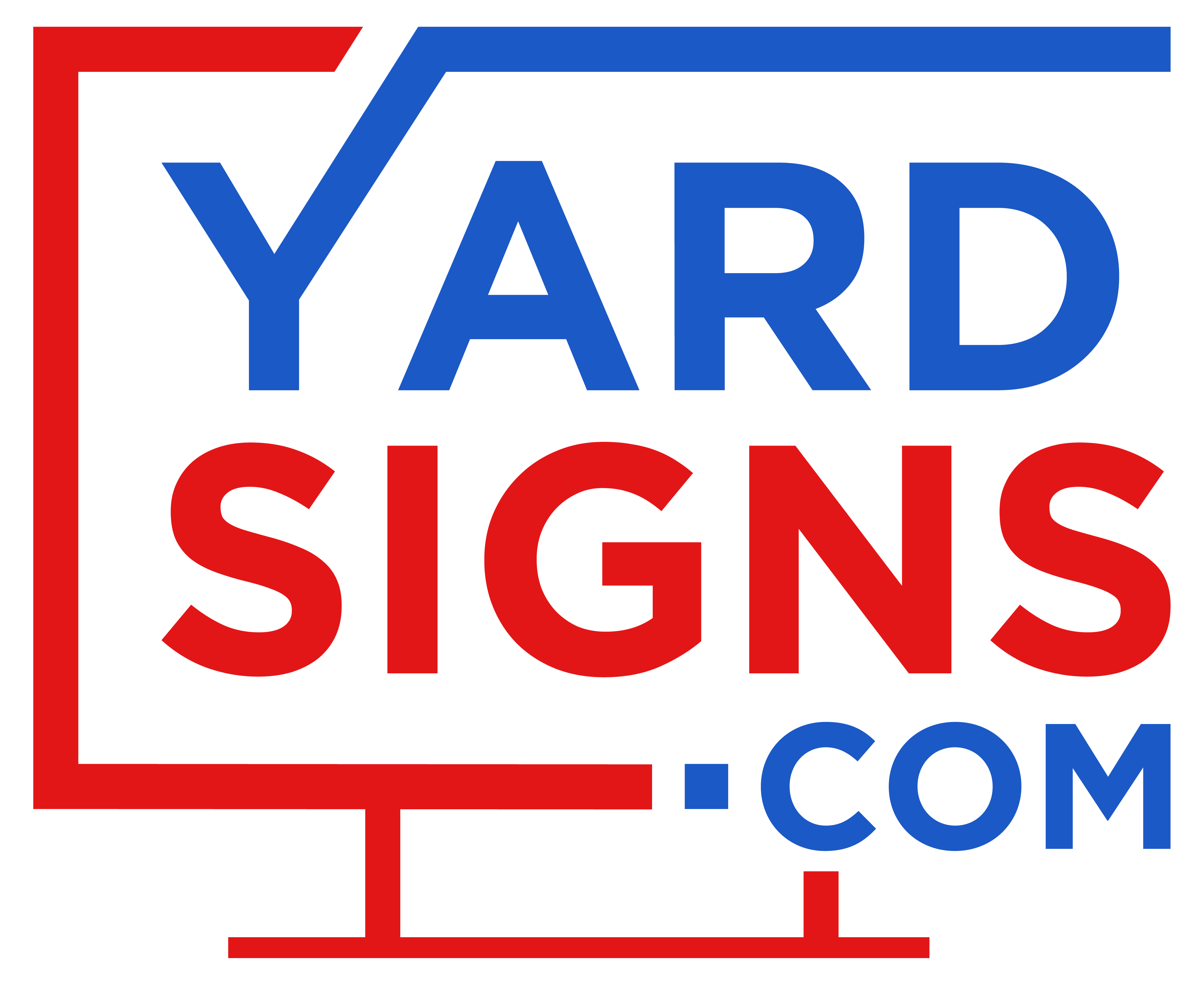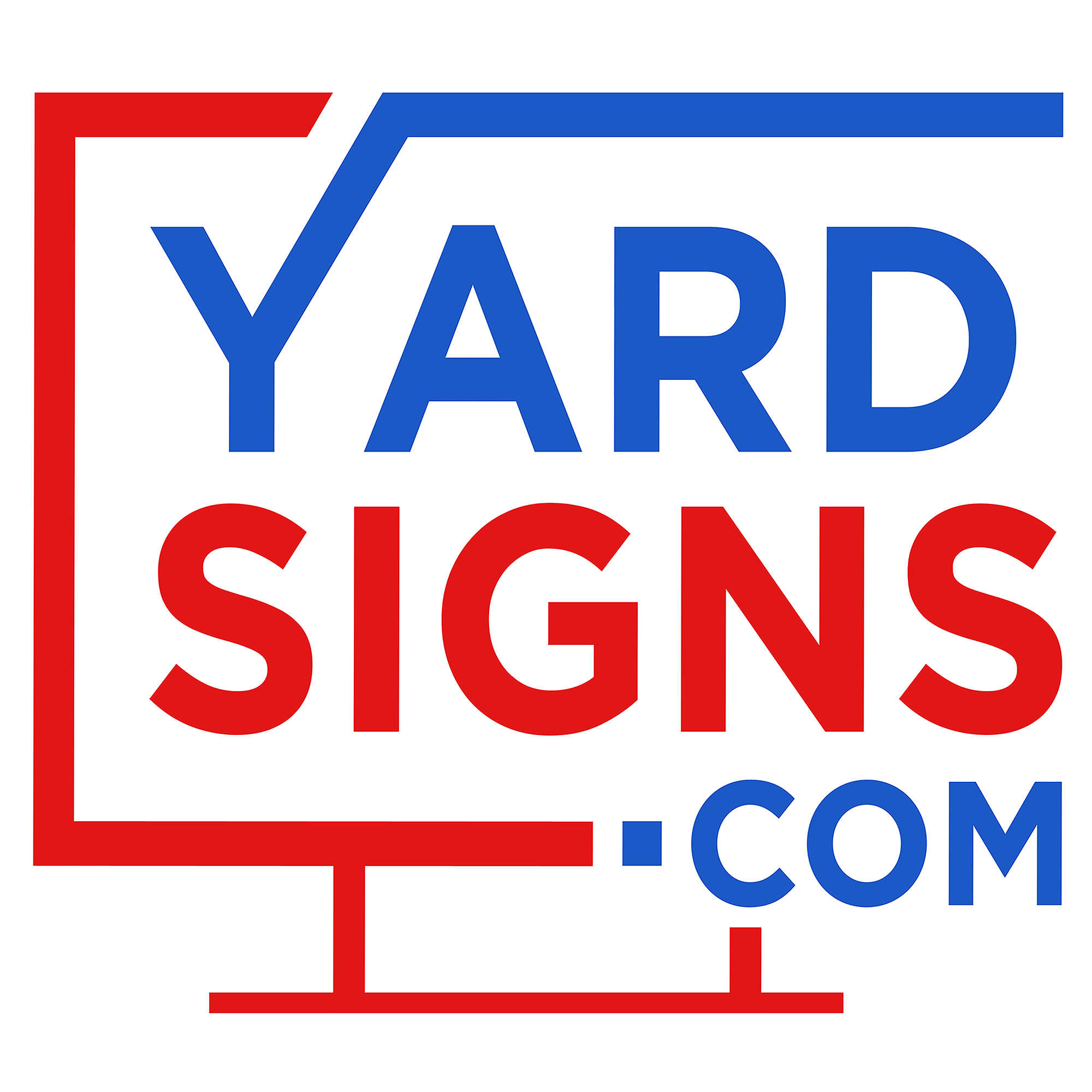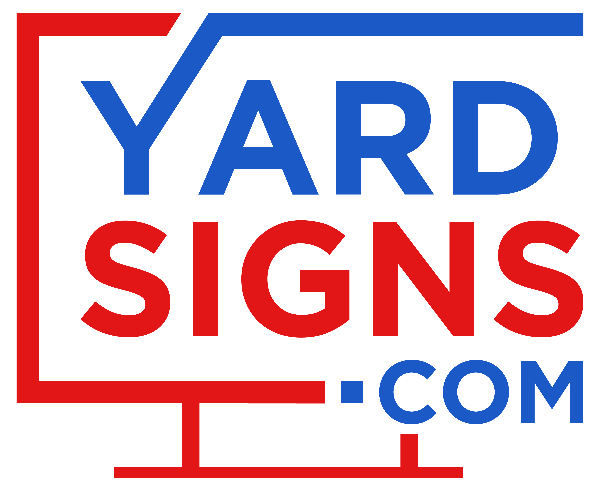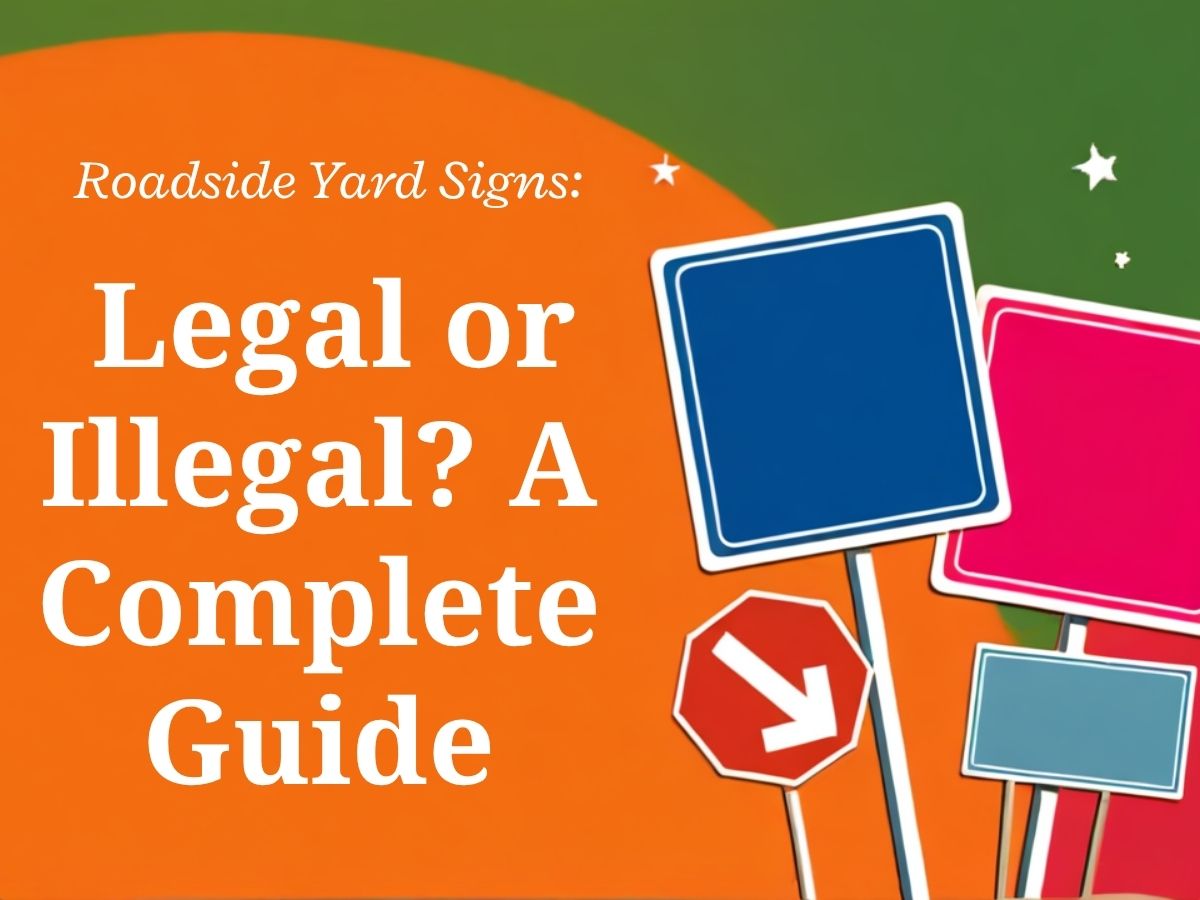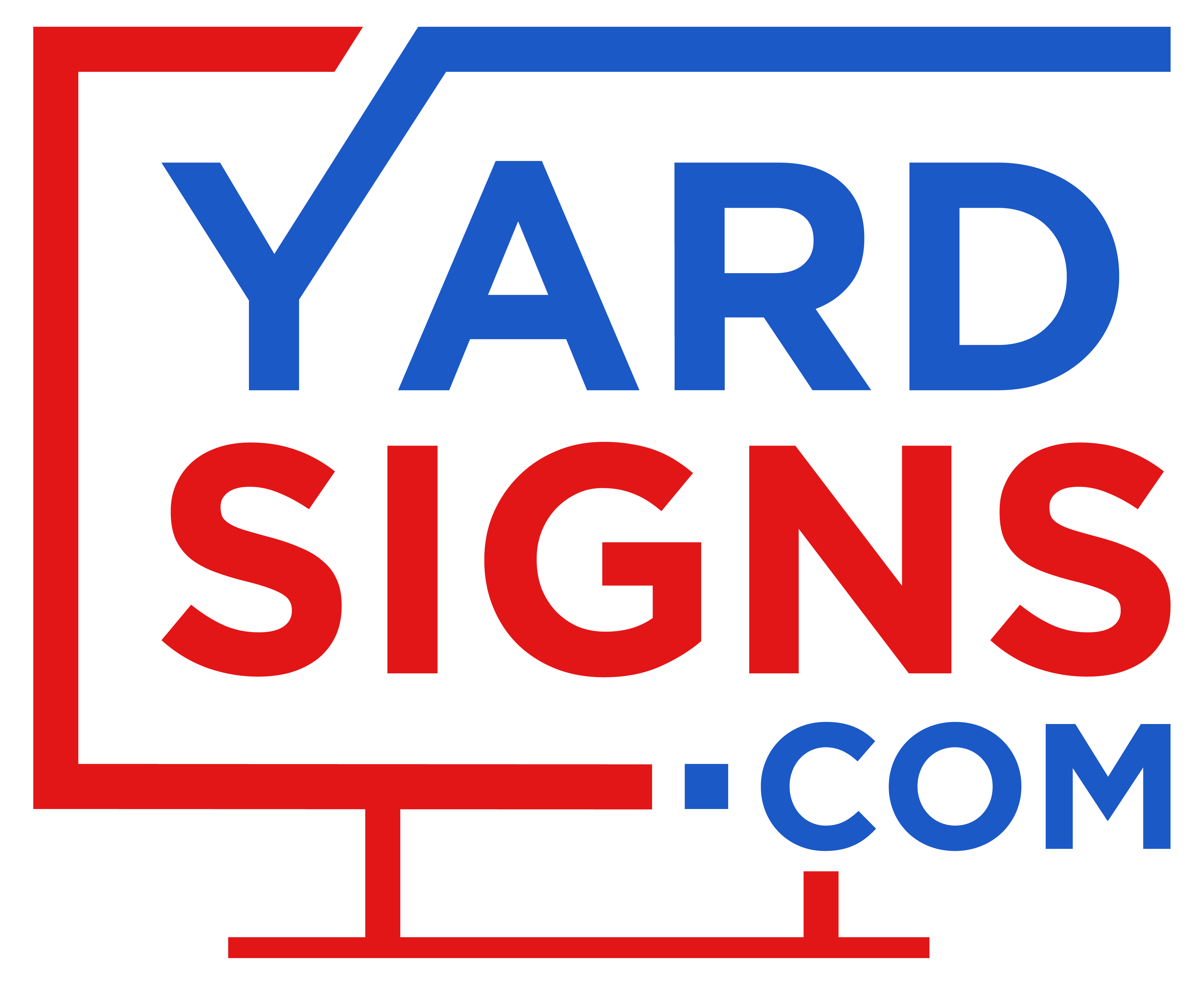Placing signs near roads is a common way to advertise a service, support a political candidate, or promote a local event. These signs can appear on street corners, intersections, and grassy areas along highways or neighborhood roads.
However, whether this practice is allowed depends on the location and the type of road. Each city, township, or state may have different rules. In many cases, placing a sign on the side of the road may break local or state laws, even if the sign seems harmless.
This guide explains the common rules for roadside sign placement, the areas where signs are usually not allowed, and how to know if a sign is legally placed.
Understanding Roadside Sign Rules
Is it illegal to put yard signs on the side of the road? In most places, yes. This is because that land is typically part of the public right-of-way, which is controlled by local or state governments.
The public right-of-way includes sidewalks, medians, and the strip of land between a road and private property. These areas are reserved for utilities, public safety, and road maintenance. Signs placed here can block views, distract drivers, or interfere with traffic flow.
Laws about roadside signs vary by city, county, and state. In most areas, placing any sign in the public right-of-way, including political, business, or real estate signs, is illegal. Some states have specific laws that make it illegal to place signs along highways or on public land next to roads.
There are some exceptions to these rules. Certain signs may be allowed with a permit or under special circumstances. The rest of this guide will explain how to find out what rules apply to your area and what legal options are available for placing signs.
Why Local Zoning and HOA Regulations Matter?
![]()
Local zoning laws contain rules about where signs can go, how big they can be, and how long they can stay in place. These laws apply to all kinds of signs, including yard signs placed on private property.
Zoning regulations differ depending on the city or county, but many follow similar rules to keep streets safe and neighborhoods consistent. These rules can apply even if a sign is placed on private land.
Most municipalities have specific rules about signs in residential areas:
- Size limitations: Residential signs are often limited to 6 square feet or less
- Setback requirements: Signs usually need to be placed 10-15 feet from roads or sidewalks
- Content restrictions: Some places limit commercial messages in residential areas
- Duration limits: Temporary signs may only be allowed for 30-60 days
Homeowners Associations (HOAs) often place stricter limits on signs than local governments. These rules are intended to maintain a uniform appearance in the neighborhood. HOAs may restrict the number of signs, require approval before placement, or prohibit certain types of signs altogether.
Zoning rules can often be found on a city or county's website, or by contacting the planning or zoning department. HOA rules are typically outlined in the association's bylaws or covenants.
Public Right of Way: Can You Place Signs There
The public right-of-way is the land that runs along roads and is typically controlled by a government agency. This includes sidewalks, medians, utility strips, and often the area between the street and the sidewalk.
Short answer: No, you generally cannot place signs in the public right-of-way legally.
These restrictions exist for several important reasons:
- To reduce distractions for drivers
- To maintain clear sightlines at intersections
- To allow access for maintenance crews and utility workers
- To prevent visual clutter along roadways
Laws that prohibit signs in these areas are often part of state or municipal codes. For example, placing signs in highway rights-of-way is prohibited by law in states such as Pennsylvania and Virginia. Federal guidelines, like the Highway Beautification Act, also place restrictions on sign placement near certain roadways.
This table shows where signs are typically allowed or prohibited:
|
Location |
Typically Legal? |
Why? |
|
Private property (with permission) |
Yes |
Property owners control their land |
|
Public right-of-way |
No |
Safety concerns and public access needs |
|
Road medians |
No |
Creates safety hazards and distractions |
|
Utility poles |
No |
Interferes with utility work and safety |
|
Street corners |
No |
Blocks visibility at intersections |
How to Determine the Right of Way Boundary
Right-of-way boundaries aren't always obvious, but there are ways to identify them:
- Utility poles and boxes often mark the edge of public land
- The area between a sidewalk and street is usually public right-of-way
- Property surveys and plat maps show exact boundary lines
- When in doubt, call your local planning department
If you're unsure whether a location is within the right-of-way, it's better to err on the side of caution and place signs only on private property with clear permission.
Do You Need a Permit or Permission?
In many places, permits are required for yard signs, especially for commercial or large signs. Smaller signs on residential property may not need a permit if they meet specific size and time requirements.
The permit process typically involves completing an application and paying a fee. Requirements vary widely between locations, so checking local rules is essential.
To find out what applies in your area:
- Visit your city or county website and look for the planning department
- Search the municipal code for “signs” or “signage”
- Call the local planning department directly
Remember: Always get permission from the property owner before placing a sign on private property. Placing signs without permission can lead to removal and potential liability issues.
Political Yard Signs: Special Requirements
Political yard signs receive special treatment under the law because they relate to free speech, which is protected by the First Amendment. However, they're still subject to reasonable restrictions on size, placement, and timing.

Many cities and counties allow political signs only during specific periods before and after an election. For example, signs might be permitted 30 days before and must be removed 7 days after an election. These timeframes vary by location.
Some jurisdictions require political yard signs to include disclaimers that identify who paid for or authorized the sign. These might read “Paid for by [committee name]” or provide sponsor information.
Missing required disclaimers can result in fines or sign removal. The rules for disclaimers are often published by state election boards or local campaign finance offices.
Despite having special protections, political signs are still generally prohibited in public rights-of-way, just like other types of signs.
Business and Real Estate Yard Signs: What to Know
Business and real estate yard signs face stricter regulations than personal or residential signs. These commercial signs typically have more limitations on:
- Maximum size: Often smaller than what's allowed for non-commercial signs
- Display duration: May be limited to specific time periods
- Placement locations: Usually restricted to commercial zones or the property being sold
- Design elements: May have restrictions on colors, materials, or lighting
Commercial signs are generally allowed on private property with the owner's permission. In commercial zones, different rules may apply than in residential areas. For example, signs might be allowed to be larger or include lighting, but only with proper permits.

Temporary commercial signs (like “Open House” signs) and permanent ones (like business identification signs) often have different requirements. Even temporary signs may need permits in some areas.
Real estate signs specifically often have exemptions that allow them to be placed on the property being sold or leased, but these exemptions rarely extend to public rights-of-way.
What Happens If You Violate Sign Laws
Placing yard signs in prohibited areas can result in consequences. Enforcement usually begins when someone files a complaint or when a code enforcement officer notices the violation.
Potential penalties include:
- Fines ranging from $50 to several hundred dollars per violation
- Escalating penalties for repeat offenders
- Removal and confiscation of the signs
Signs placed illegally may be removed by public officials without warning, especially from public rights-of-way, utility poles, or road medians. In some places, removed signs are held for a limited time and can be retrieved by paying a fee. Unclaimed signs are typically discarded after a set period.
Not knowing about sign regulations doesn't prevent these consequences. The responsibility falls on the person placing the sign to understand and follow local rules.
Safety and Visibility Tips for Roadside Signs
Even when signs are legally placed on private property near roads, safety considerations are important. Signs should never block sightlines for drivers or pedestrians, especially at intersections or driveways.
To avoid creating hazards:
- Keep signs at least 30 feet from intersections
- Place signs 10 feet or more from driveways and sidewalks
- Use durable materials that won't become debris in bad weather
Weather-resistant materials like corrugated plastic or aluminum help prevent signs from breaking down, blowing away, or becoming litter. Quality signs from reputable suppliers like Yardsigns are designed to withstand outdoor conditions while maintaining visibility and appearance.
Key Takeaways
The answer to “Is it illegal to put yard signs on the side of the road?” is generally yes if the “side of the road” is part of the public right-of-way. This includes areas like:
- The strip of grass between sidewalks and streets
- Road medians and traffic islandsQ
- Areas around utility poles and boxes
- Public land adjacent to highways
However, yard signs are usually legal when placed on private property with the owner's permission, though they must still comply with local zoning rules and HOA regulations where applicable.
The safest approach is to place signs only on private property where you have explicit permission, and to check local ordinances before doing so. For political campaigns, events, or businesses needing effective signage, custom yard signs designed to meet local requirements provide a legal alternative to roadside placement.

Scan the QR Code to place an order for your custom yard sign today at Yardsigns.com and start building your local presence with high-quality, attention-grabbing designs delivered right to your door.
FAQs About Roadside Yard Signs
Can I place yard signs on my own property?
Yes, you can generally place yard signs on your own property, though local zoning ordinances and HOA rules may limit their size, number, and content. These private property signs are subject to fewer restrictions than those in public areas.
How do I find my local sign regulations?
Contact your city or county planning department or visit their website to find specific sign ordinances for your area. Most municipalities publish their codes online, searchable by terms like “sign ordinance” or “zoning code.”
What happens if someone places a sign on my property without permission?
You have the legal right to remove any unauthorized signs from your private property. Some jurisdictions also allow you to report unauthorized sign placement to local code enforcement authorities.
Are there different rules for political yard signs?
Political signs often have special protections due to free speech considerations, but they're still subject to reasonable size and placement regulations. Many areas allow political signs only during specific periods before and after elections.
Can I place temporary yard signs for events or yard sales?
Temporary event signs are typically allowed on private property with the owner's permission. Many local regulations limit how long these signs can be displayed (often 2-14 days) and how large they can be. These signs are generally not allowed in public rights-of-way.
